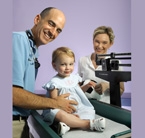
Falls Church, Va., pediatrician Eduardo Fox with his young biliary atresia patient Sydney Moss and her mom, Lindsay.
Though Sydney Moss came into the world four weeks early, she appeared pink and healthy. But when pediatrician Eduardo Fox first met her in Inova Fairfax Hospital in Northern Virginia a few days after her birth, she looked jaundiced enough for Fox to not take any chances and begin monitoring her liver enzymes. Early detection of pediatric liver disease, he knew, is critical for successful outcomes.
Indeed, the infant’s bilirubin levels were high and remained high over the next few weeks, which led to her diagnosis of biliary atresia, a blockage or absence of the bile duct, and referral to the Pediatric Liver Center at Johns Hopkins. There she was able to undergo the Kasai procedure—in which the bile duct is reconstructed with a loop of intestine—well within the preferred timeframe of 8 to 12 weeks. Lindsay Moss, Sydney’s mother, credits Fox for this early intervention that reduces the risk of liver failure and the need for liver transplant within the first 1 to 2 years of life.
“These kids can go months before anything is detected, and then it’s too late and they have to be transplanted immediately,” says Moss. “But Dr. Fox and the staff knew this needed to be closely watched and pushed to have the bilirubin tests done. Since then, he’s been our go-to guy.”
But aggressively following up on the early signs of liver disease is just one aspect of managing it, notes Fox of Sleepy Hollow Pediatrics, a mid-size suburban practice in Falls Church, Va. Quick referral to a pediatric liver center, as well as constant communication and coordination with the liver specialists and the family, are all key to optimum care.
“I tell the parents that they want to be in a place where their child’s problem is something they often see,” Fox says. “Then all that needs to happen happens automatically because the systems are already in place. If you’re one of a few patients, things get dropped.”
Much of the communication surrounding Sydney’s care happens virtually among Hopkins Children’s hepatologist Kathy Schwarz and her staff, pediatrician Fox and the parents. Whether the subject is Sydney’s feeding and growth, her latest liver labs, or her risk of infection, all of the participants are in the loop in real time via cell or e-mail. That loop proved vital, notes Moss, when Sydney developed a bacterial colangitis infection while the family was vacationing in Atlanta, some 700 miles from Hopkins Children’s. Schwarz and Fox and their respective staffs, whom Moss refers to as “Sydney’s Pit Crew,” came to the rescue.
“What comforts me most is the access,” she says. “We paged Dr. Schwarz on New Year’s Day in Atlanta and she responded immediately and arranged for Sydney to be admitted down there. With Dr. Fox, it’s been constant open communication.”
“When she has those acute flare-ups, we have labs done in the hospital and subsequent to her hospitalization to make sure everything is in sync,” Fox adds. “Even when she’s well, we check her labs every two to three months because of her risk of infection.”
In the care plan for a patient with a complex chronic condition like liver disease, all may not be in agreement all the time. For instance, when different opinions surfaced from Fox, Schwarz and an outpatient feeding clinic regarding the most appropriate infant formula for Sydney, Moss stresses, Fox brought the group together.
“He e-mailed everybody, asked if we could get on the same page, which I really appreciated,” she says. “I don’t know if there’re many doctors who would try to wrangle all those experts, but we all talked about it and came to the same conclusion about the best path for Sydney.”
Managing a chronically ill child like Sydney also means being aware of the parents’ needs, Fox notes. Even confident, fully engaged parents like Lindsay and her husband, Stephen, may struggle with caring for their child.
“Sometimes you have to remind yourself that it’s still scary for parents, even those parents who have the ability to be proactive,” Fox says. “I tell them we’re going to work on this together, and you don’t have to figure it all out.”
“Dr. Fox keeps it real for us and looks at the big picture,” concludes Moss. “It’s reassuring to know someone is always there to help you with your child.”
